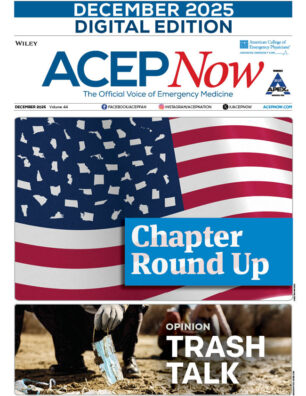Patrick H. Conway, MD, MSc, has had an interesting journey. He is a Texas resident who became a pediatrician after his residency at Harvard Medical School at Boston Children’s Hospital and is still practicing clinically. He was a White House fellow and then worked his way up through the federal government.
Explore This Issue
ACEP Now: Vol 36 – No 09 – September 2017He is currently the deputy administrator for innovation and quality at the Centers for Medicare & Medicaid Services (CMS) and director of its Center for Medicare & Medicaid Innovation (CMMI). He also sees patients as a pediatric hospital medicine attending, and his clinical work helps shape his policy work at CMS.
In his various roles, he keeps four important job criteria in mind:
- Family
- Impact (the Triple Aim)
- Learning
- People, which originally meant mentorship but has grown to encompass the people and culture of the organization

Dr. Ricardo Martinez
PHOTO: Ricardo Martinez
Dr. Conway recently sat down with ACEP Now editorial board member Ricardo Martinez, MD, FACEP, chief medical officer for Adeptus Health in Lewisville, Texas, and assistant professor of emergency medicine at Emory University in Atlanta, to discuss his role at CMS and what the future may hold for emergency medicine.
RM: Patrick, you’ve had a very interesting journey, both in health care and in government. What drives you?
PC: What drives me, and has for probably the last 20 years, is trying to have the largest positive impact on the US health system possible. I know that sounds like a bold goal, and I certainly struggle to achieve it at times, but I’ve been really focused on better care, better health, and lower cost throughout my career. As you’ve mentioned, I’ve been in government through a couple tours of duty and probably would not have predicted that when I was in my first job at McKinsey Consulting before I went to medical school. The core of what I’m passionate about is how to deliver better care to people and to populations of patients.
RM: You’re at the Department of Health and Human Services during a very interesting time. In truth, government work gives you low pay and long hours but an opportunity to make a great difference. One of the roles you have is director of CMMI. Can you tell us a little bit about that organization and some of the innovations that you’ve seen?
PC: I came in originally to CMS as the chief medical officer and ran our quality center. Don Berwick was the administrator at the time and then, over four years ago, he was asked to run CMMI, the innovation center. The whole point of the innovation center is to test new payment and service delivery models like accountable care organizations, bundled payments, primary care medical homes, and state-based innovation. If those models improve quality and lower cost for patients, then we’re able to scale those models up nationally. The innovation center is really an exciting sort of innovation engine. It’s funded at $10 billion over every 10 years, but the scale of change can be enormous. Just to give you a few numbers, we put out a report to Congress at the end of last year, and we now are working with over 200,000 providers—and even more physicians because a provider can be a hospital, a physician group, or a post-acute facility. Those providers are serving about 27 million patients directly and over 200 million Americans indirectly.
RM: Kaiser has an acute care strategy that actually sends more patients to the emergency department than it does to urgent care because it allows them to get a diagnosis quickly and put that patient in the right cost of care and the right place of care. Does CMMI have any programs that begin to follow patients across their continuum and that may help put a greater focus on that, or do you see that as something we need to do as a profession?
PC: That’s a great question. The vast majority of our models actually look at total cost of care as a metric, which I think is the right metric. We sometimes get pushback on this that physicians or clinicians only want to be responsible for their niche of care, but I think we’re trying to build a system with physicians, clinicians, and providers that is highest quality at lower cost for the total patient experience. Our focus is really on quality outcomes over time for patients and total cost of care for patients in the health care system.

Dr. Patrick Conway
ACOs are realizing emergency care, urgent care, and acute care are critical pieces of their success. I think you’ll see that grow in the bundled payment and episode-based payment arena. We certainly have inpatient bundles now, but I think you’re going to see even more outpatient bundles, and you should see bundles around emergency care as well. – Dr. Patrick Conway
RM: What do you see as the biggest changes in health care systems over the next five to eight years?
PC: I think we are seeing accountable care organizations (ACOs) continue to grow. We have over 500 now for over 12 million Medicare beneficiaries. Even more important, we have about 120 two-sided risk ACOs, whereas we had about 20 just a couple of years ago. Increasingly, those ACOs are realizing emergency care, urgent care, and acute care are critical pieces of their success. I think you’ll see that grow in the bundled payment and episode-based payment arena. We certainly have inpatient bundles now, but I think you’re going to see even more outpatient bundles, and you should see bundles around emergency care as well.
As for the state- and community-based programs, we’re seeing states like Vermont develop a program that is an all-payer ACO putting all of its patients, beneficiaries, and people into care systems often anchored with a hospital with its associated emergency network and clinics. In state-based innovation, you’ll see the critical role for emergency care grow. In the last year, I’d call out the telehealth, remote monitoring, and patient engagement technology arenas. Increasingly, we’re going to see a focus on consumer-driven care and how you manage the patients outside of the hospital, the clinic, etc. How do you manage them at home? How do you keep them healthy and avoid admissions? You’re going to see growth in emergency medicine using remote technology and other electronic means of communicating and interacting with patients, including telehealth.
RM: We’re proud of your success as a clinician leader and not only with what you believe but what you do. I will tell you, for all the emergency physicians out there, we’re the only place in the health care system that’s open 24 hours a day and takes care of everyone. We really look forward to working together with you and your team. Thank you, Patrick.
PC: Thank you, Ric.
Editor’s Note: After this interview was conducted, it was announced that Dr. Conway is leaving CMS to become president and CEO of Blue Cross Blue Shield of North Carolina, starting Oct. 1.
Pages: 1 2 3 | Multi-Page




No Responses to “CMS Administrator Dr. Patrick Conway Discusses Health Care Innovation, Costs, Technology”